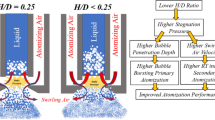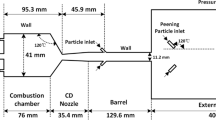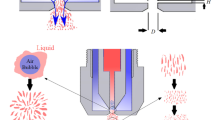Abstract
In this work, the effects of fuel temperatures and pressure drops on the flow field and spray characteristics of a pressure-swirl atomizer were discussed using the Particle Imaging Velocimetry (PIV), Planar Laser Induced Fluorescence (PLIF) and Laser Particle Size Analyzer (LPSA) methods. Then the air-blast atomizer was selected to study the interaction of initial atomization and flow field. The effect of fuel-air ratio on the air-blast atomizer were also considered, where the fuel-air ratio was varied by adjusting mass flow rate of the air and fuel respectively. The results show that the spray angle of the pressure-swirl atomizer increases first and changes a little after the pressure drop higher than 0.5 MPa. However, more fuel concentrate on the central region, which is mainly caused by the increase of the proportion of small droplets with lower centrifugal force. The fuel temperature can improve the spray angle only in lower pressure drop, and it has a little effect under higher pressure drops. In addition, the fuel pressure drop has an obvious influence on the fuel distribution and flow field near the nozzle exit compared with the downstream. For the air-blast atomizer, the spray angle increases compared with the pressure-swirl atomizer for the introduction of swirl air. Furthermore, the spray angle decreases with the air mass rate increasing, and it increases with the fuel mass rate increasing. The distribution of velocity and droplet near the nozzle exit is influenced by the air mass rate, and the fuel mass rate mainly affects the distribution in the downstream. The fuel accumulates in the annular area below the nozzle, and the distribution of it changes little with the development along the axial direction.
Similar content being viewed by others
Abbreviations
- A :
-
area of the nozzle exit/m2
- CCD:
-
Charge-Couple Device
- C d :
-
discharge coefficient
- D :
-
diameter of cross-sectional plane/m
- H :
-
distance from exit of atomizer/m
- m :
-
mass flow rate/g·s−1
- LPSA:
-
Laser Particle Size Analyzer
- ΔP :
-
pressure drop/MPa
- PDPA:
-
Phase Doppler Particle Analyzer
- PIV:
-
Particle Imaging Velocimetry
- PLIF:
-
Planar Laser Induced fluorescence
- SMD:
-
Sauter mean diameter/µm
- T :
-
temperature/°C
- β :
-
spray cone angle/°
- ρ :
-
density of fuel/kg·m−3
- a:
-
air
- f:
-
fuel
References
Gan X.H., Aero gas turbine engine fuel nozzle technology. Vol. 4. National Defense Industry Press, Beijing, China, 2006, pp. 36–50.
Lefebvre A.H., Wang X.F., Mean drop sizes from pressure-swirl nozzles. Journal of Propulsion & Power, 1987, 3(1): 11–18.
Marchione T., Allouis C., Amoresano A., et al., Experimental investigation of a pressure swirl atomizer spray. Journal of Propulsion and Power, 2007, 23(5): 1096–1101.
Amini G., Liquid flow in a simplex swirl nozzle. International Journal of Multiphase Flow, 2015, 79: 225–235.
Kim S., Khil T., Kim D., et al., Effect of geometric parameters on the liquid film thickness and air core formation in a swirl injector. Measurement Science and Technology, 2009, 20(1): 015403.
Xue J., Jog M.A., Jeng S.M., et al., Effect of geometric parameters on simplex atomizer performance. AIAA Journal, 2004, 42(12): 2408–2415.
Rashid M.S.F.M., Hamid A.H.A., Sheng O.C., et al., Effect of inlet slot number on the spray cone angle and discharge coefficient of swirl atomizer. Procedia Engineering, 2012, 41: 1781–1786.
Lefebvre A.H., Wang X.F., Mean drop sizes from pressure-swirl nozzles. Journal of Propulsion & Power, 1987, 3(1): 11–18.
Rizk N.K., Lefebvre. A.H., Internal flow characteristics of simplex swirl atomizers. Journal of Propulsion and Power, 1985, 1(3): 193–199.
Yang L., Ge M., Zhang X., et al., Effects of spout length on spray characteristic of swirl injector. Journal of Propulsion Technology, 2005, 26(3): 209–214.
Yang L.J., Fu Q.F., Qu Y.Y., et al., Spray characteristics of gelled propellants in swirl injectors. Fuel, 2012, 97: 253–261.
Chen J., Ji H., Zhang B., Experimental investigation of spray characteristics of a double line pressure-swirl atomizer. Journal of Aerospace Power, 2010, 25(4): 774–779.
Zhang T., Dong B., Chen X., et al. Spray characteristics of pressure-swirl nozzles at different nozzle diameters. Applied Thermal Engineering, 2017, 121: 984–991.
Chen C., Yang Y., Yang S.H., et al., The spray characteristics of an open-end swirl injector at ambient pressure. Aerospace Science and Technology, 2017, 67: 78–87.
Liu K., Research of the atomization characteristics of low pollution air blast nozzle. Advanced Materials Research, 2013, 655–657: 133–136.
Roudini M., Wozniak G., Experimental investigation of spray characteristics of pre-filming air-blast atomizers. Journal of Applied Fluid Mechanics, 2018, 11(6): 1455–1469.
Dvorak D., Peck S., Hu H., An experimental investigation on the spray flows exhausted from a counter-swirling air-blast nozzle. Aerodynamic Measurement Technology, Ground Testing, & Flight Testing Conference. 2013. DOI: https://doi.org/10.2514/6.2012-3114.
Ma R., Dong B., Yu Z., et al., An experimental study on the spray characteristics of the air-blast atomizer. Applied Thermal Engineering, 2015, 88: 149–156.
Guo X.H., Lin Y.Z., Zhang C., et al., Experiment investigation on atomization characteristic of an air-blast atomizer with centrifugal nozzle and co-dual-swirl cup. Journal of Aerospace Power, 2009, 24(10): 2249–2254.
Liu C.X., Liu F.Q., Yang J.H., et al., Experimental investigations of spray generated by a pressure swirl atomizer. Journal of the Energy Institute, 2019, 92(2): 210–212.
Akamatsu F., Optical measurement and numerical simulation of spray combustion. Journal of Thermal Science and Technology, 2016, 11(1): JTST0002.
Liu F.Q., Zhang K.Y., Mu Y., et al., Experimental investigation on ignition and lean blow-out performance of a multi-sector centrally staged combustor. Journal of Thermal Science, 2014, 23(5): 480–485.
Lee E.J., Oh S.Y., Kim H.Y., et al., Measuring air core characteristics of a pressure-swirl atomizer via a transparent acrylic nozzle at various Reynolds numbers. Experimental Thermal and Fluid Science, 2010, 34(8): 1475–1483.
Fan X.J., Liu C.X., Mu Y., et al., Experimental investigations of flow field and atomization field characteristics of pre-filming air-blast Atomizers. Energies, 2019, 12(14): 2800.
Liu C.X., Liu F.Q., Yang J.H., et al., Investigations of the effects of spray characteristics on the flame pattern and combustion stability of a swirl-cup combustor. Fuel, 2015, 139: 529–536.
Liu C.X., Liu F.Q., Yang J.H., et al., Experimental investigation of spray and combustion performances of a fuel-staged low emission combustor Part I: Effects of main swirl angle. Journal of Engineering for Gas Turbines and Power, 2017, 139(12): 121502.
Acknowledgments
This work was supported by National Science and Technology Major Project (Project No. 2017-III-0007-0032 and No. 2017-III-0002-0026) and Youth Innovation Promotion Association, Chinese Academy of Science (No. 2019147).
Author information
Authors and Affiliations
Corresponding authors
Rights and permissions
About this article
Cite this article
Wang, K., Fan, X., Liu, F. et al. Experimental Studies on Fuel Spray Characteristics of Pressure-Swirl Atomizer and Air-Blast Atomizer. J. Therm. Sci. 30, 729–741 (2021). https://doi.org/10.1007/s11630-021-1320-z
Received:
Published:
Issue Date:
DOI: https://doi.org/10.1007/s11630-021-1320-z




